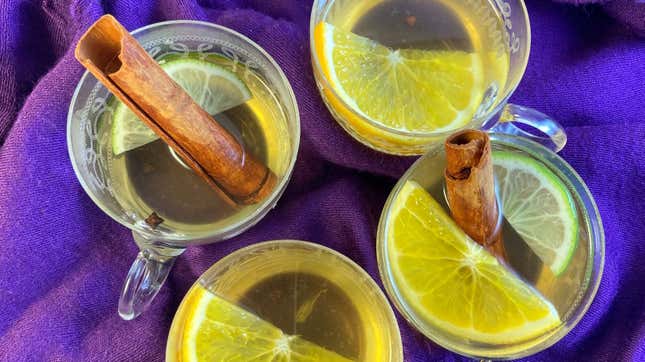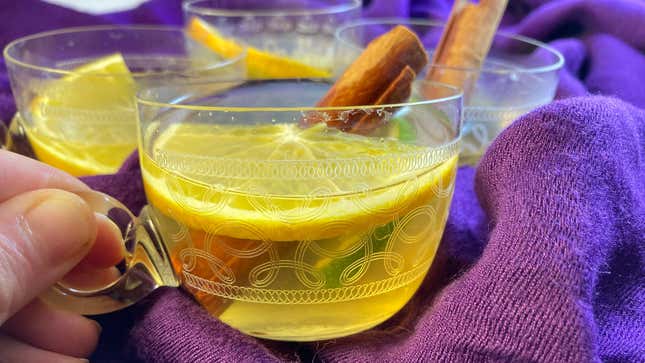
Mulled wine is the bread pudding of party drinks. Just as old hot dog buns are given new life in a baked custard, vinegary bottles of red, white, and rosé can be revived in the mulling pot. It’s a beloved holiday staple for many, but mulled wine carries a bad reputation for being overly sweet. It doesn’t have to be that way! Here’s a foolproof method for producing the best mulled wine possible, and all the questions you’ll need to ask yourself in the process.
How old is too old?
Bottles of wine are typically safe to cook with for months after being opened if they’re refrigerated, and at least a month if they aren’t. If you’re wondering whether a bottle is too old to use, hold it up to the light and look to see if there’s any sediment in a red wine or funky color change in a white wine. If it looks clear and hasn’t darkened in color, you’re probably safe to use it, but consider bringing the wine to a full boil before adding your other ingredients. You can make up for whatever alcohol is lost in this process when you spike the wine with liquor (more on that later).
What type of wine is best?
The best type of wine to mull is the wine that you already own and can’t use in any other way. Some recipes suggest using a specific type of wine, but this is silly advice since heating wine causes it to lose most of its distinguishable aromas and flavors. The cheapest bottle you can find is likely to taste pretty similar to a pricey bottle after it’s been heated, so don’t hesitate to combine multiple wines if you’ve got them. While red wine is more commonly used as a base, white wine works just as well.
A foolproof method for mulling
When you’re making mulled wine, approach it like you’re mixing a cocktail with a specific ratio of hard alcohol, mixer, and garnish in each glass. Keep in mind that one bottle of wine holds about five 5-oz. servings.
First add your wine to the pot, then rifle through your pantry for baking spices. Cloves, cinnamon sticks, star anise, and cardamom are traditional, but I’ve heard that chai tea bags are a great substitute if you don’t have many spices. For each bottle of wine I use 10 cloves, 1 cinnamon stick, and either 1 pod star anise (if you’re using red wine) or 2 thumb-sized pieces of fresh ginger (if you’re using white wine). I’m a sucker for cloves, so they’re the predominant spice in my mix, but if you prefer, say, cinnamon, simply cut the number of cloves by half and double the cinnamon. When using cardamom, crush the pods before tossing them into the pot.
Next, add some fruit for flavoring while keeping a bit set aside for garnishing glasses later. Oranges are classic, but sliced apple and pear are also common. I use a bit of lime zest when I’m mulling white wine. As a general rule of thumb, you can add as many as two or three types of fruit before it becomes fruit punch, and just one fruit of each type per each bottle of wine. So maybe a lime and an orange with any old bottle of white, or an apple, pear, and orange with a spicy Gewurztraminer? Use a vegetable peeler to remove citrus peels. Halve and squeeze oranges for their juice and drop the husks in the pot for stewing. If you have any juice on hand—orange, apple, cranberry, etc—you can add a bit for sweetening if you want. Then heat the contents of the pot just to a simmer. As soon as you see bubbling in the pot, reduce the heat to very low. Taste the wine mixture and stir in a bit of sugar if necessary. After 10 minutes at a low temperature, the spices will be infused with the wine, but you can keep the pot heated on low for hours and it’ll only gain flavor with time.

Portion the wine into each glass and spike with the liquor of your choice—brandy, bourbon, and rum are safe bets. Try adding a bit of something fun like an amaro or fruit-flavored liqueur to taste. If you’d rather spike the whole batch, be sure to keep the pot on the lowest heat possible and calculate the exact number of portions in your batch so you don’t overpower the whole mixture with booze.
Mulling over any questions? Ask away in the comment section below!